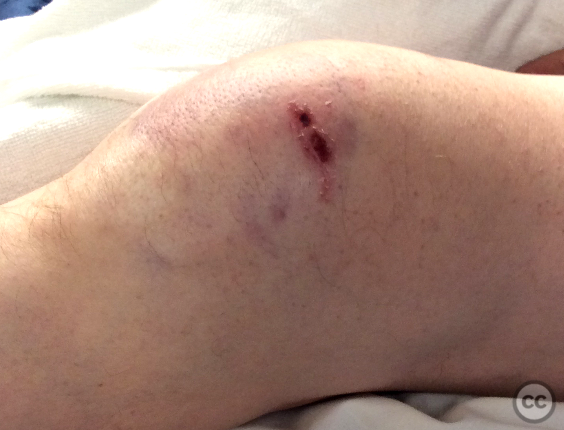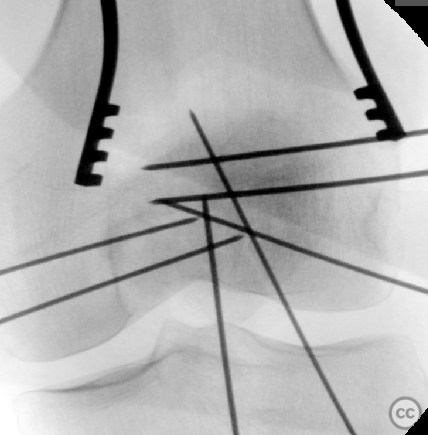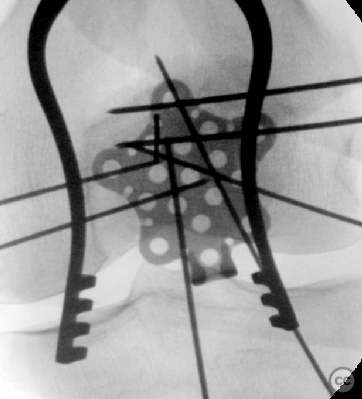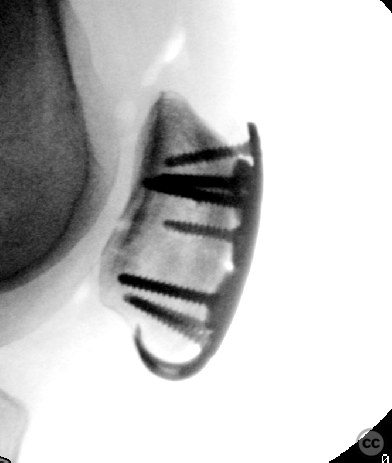Multifragmentary Patella Fracture - Plate Osteosynthesis and Cobweb Suture Technique
Score and Comment on this Case
Clinical Details
Clinical and radiological findings: A 56-year-old male presented after a moderate energy injury involving a direct blow to the knee, resulting in a tense bursal hematoma overlying a multifragmentary patella fracture. The patient reported significant subjective pain, and examination revealed considerable soft tissue tension necessitating same day semi-emergent operative management.
Preoperative Plan
Planning remarks: The preoperative plan included plate osteosynthesis for the patella fracture, utilizing fragment-specific fixation techniques. Additionally, cobweb suture fixation was planned for the peripheral retinacular avulsion fragments.
Surgical Discussion
Patient positioning: The patient was positioned supine on the operating table, with a roll placed under the knee to maintain approximately 15 degrees of intraoperative flexion, facilitating access and visualization of the patella.
Anatomical surgical approach: A midline incision was employed. Following incision, an extensive debridement of the hematoma and bursa was performed.
Operative remarks:Initial steps involved fragment-specific reduction, employing poly-L-lactic acid (PLLA) pins to assemble small articular fragments into larger, more manageable blocks. These blocks were then reduced and temporarily held in place with multiple Kirschner wires. A reduction clamp followed by the application of an Arthrex suture plate, with an inferior pole hook inserted through perforations in the patellar tendon. Proximal and distal locking screw fixation restored the integrity of the extensor mechanism through a bridgeplate construct. Subsequently, cobweb suture adaptation was utilized for the retinaculum and avulsion fractures, suturing them back to the plate. Stability was confirmed through preliminary range of motion testing to 30-40 degrees on the operating table.
Follow up: Not specified.
Orthopaedic implants used: Arthrex suture plate with inferior pole hook, Arthrex TrimIt PLLA pins
PubMed® Literature Review
Generated by The Literature - Realtime PubMed® AnalysisPatellar fractures are a common orthopedic injury. Traditional treatment modalities have predominantly utilized metallic implants for internal fixation; however, these approaches often necessitate subsequent surgeries for hardware removal due to complications like irritation [1][7]. As a result, there has been growing interest in exploring non-metallic alternatives such as high-strength sutures and anchor systems that promise reduced complication rates while maintaining or improving functional outcomes [2][5][8].
The use of non-metallic implants like FiberWire tension bands has shown satisfactory clinical results with low incidence rates of complications and reoperations [7]. This is corroborated by studies demonstrating good bone union times without significant loss of reduction using modified tension band wiring techniques employing high-strength sutures [6][9]. Moreover, minimally invasive procedures utilizing suture materials have been advocated to decrease surgical trauma and facilitate quicker rehabilitation compared to traditional metal-based fixation methods [2].
In response to these challenges, Moser-De Mesa et al. introduced a novel technique termed as "Cobweb Technique", utilizing modified cerclage and suture mesh fixation with high-strength braided nonabsorbable sutures for treating comminuted patellar fractures.
This method aims at providing anatomic articular reduction while ensuring stable fixation that permits early mobilization and minimizes the risk of knee stiffness—a common complication when movement is delayed or inadequate post-surgery. The cobweb technique specifically addresses concerns related to traditional metallic implant use by eliminating symptomatic hardware issues through its reliance on nonabsorbable sutures for fracture stabilization.
The technical complexity inherent in managing comminuted patellar fractures lies not only in achieving anatomical reduction but also in maintaining it through stable fixation without impeding early range-of-motion exercises critical for recovery. The cobweb technique's utilization of a suture mesh creates a tension band effect across the fracture site, theoretically distributing forces more evenly than rigid metal implants and allowing some degree of flexibility that might be beneficial during rehabilitation phases.
Despite its promising approach, being reported as a case study limits the strength of evidence provided by Moser-De Mesa et al.'s work [1]. Case reports are valuable for introducing novel techniques or highlighting rare conditions but lack statistical power and control over variables that higher levels of evidence provide—such as randomized controlled trials or systematic reviews. Therefore, while this innovative technique offers an intriguing alternative to conventional methods, further research with higher-level studies is necessary to validate its efficacy comprehensively, assess long-term outcomes including rates of union versus nonunion or reoperation due to failure or complications directly associated with suture-based techniques compared against traditional methods.
Comparative studies between conventional K-wire tension banding versus newer suture-based methods indicate several advantages with the latter approach including smaller incision sizes, less intraoperative bleeding, reduced postoperative pain levels, faster recovery timescales, and lower secondary surgery rates due to hardware-related issues [11][12]. Furthermore, these innovative suture configurations provide robust mechanical stability conducive for early mobilization practices essential for optimal knee joint function recovery post-fracture repair.
Despite promising outcomes associated with non-metallic implant strategies like cobweb-like suture fixations for patellar fractures—highlighted by improved knee joint mobility scores and decreased complication risks—the level-of-evidence remains relatively moderate given the preponderance of retrospective study designs over randomized controlled trials within available literature sources. Consequently, further research incorporating higher-level evidence studies is warranted to definitively establish these approaches' efficacy relative to traditional metal implant methodologies.
In conclusion, emerging evidence suggests that non-metallic implant strategies leveraging advanced suturing techniques offer viable alternatives for managing patellar fractures effectively while mitigating common drawbacks associated with metallic fixation devices. These findings underscore an evolving paradigm shift towards less invasive yet mechanically sound repair mechanisms capable of fostering enhanced patient outcomes following patellar injuries.
Search for Related Literature

Dr Ed Oates
- Germany , Schleswig Holstein
- Area of Specialty - General Trauma
- Position - Specialist Consultant

Industry Sponsership
contact us for advertising opportunities













Article viewed 711 times
12 Mar 2024
Add to Bookmarks
Full Citation
Cite this article:
Oates, E.J. (2024). Multifragmentary Patella Fracture - Plate Osteosynthesis and Cobweb Suture Technique. Journal of Orthopaedic Surgery and Traumatology. Case Report 4528364 Published Online Mar 12 2024.